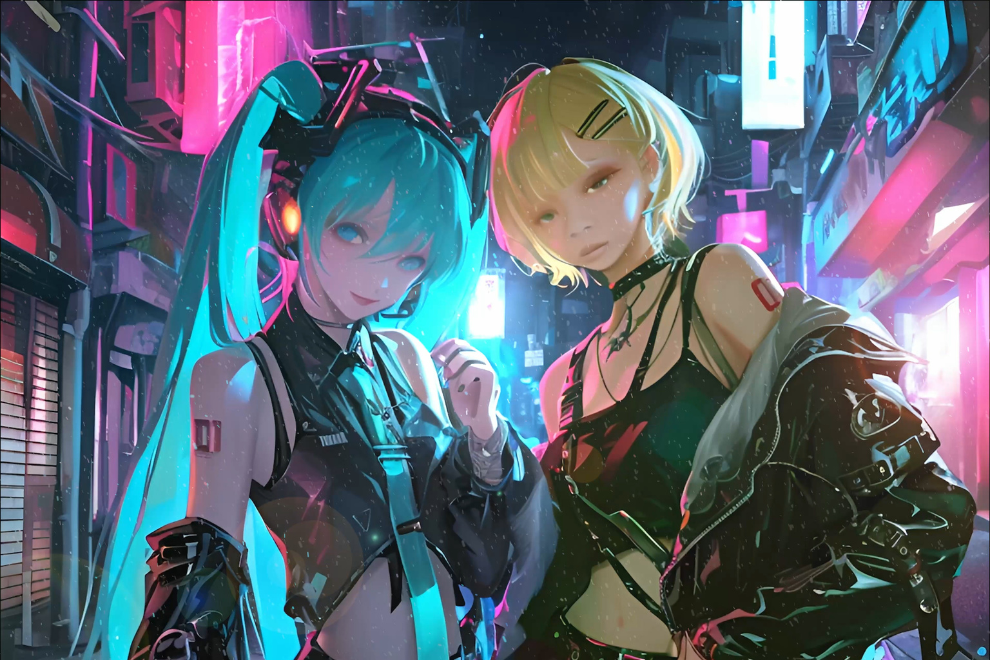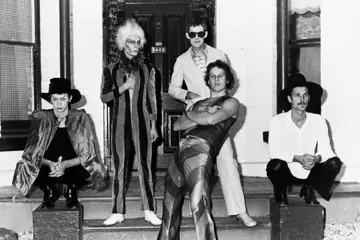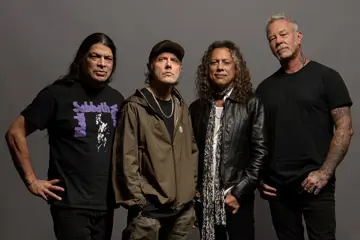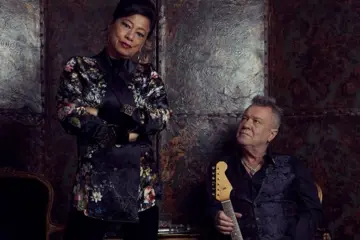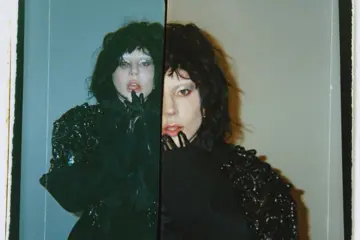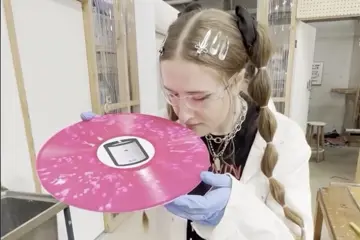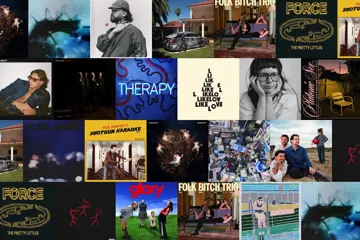Say kon'nichiwa or hello buddy! to one of Japan’s biggest music megastars.
Hatsune Miku is a 16-year-old girl with 2.5 million Facebook followers, who has uploaded 100,000 songs and 170,000 YouTube music videos for 1.55 million subscribers.
She has collaborated with Pharrell Williams, opened for Lady Gaga, and sells out clubs and theatres in Europe and the US. Last year, she played Coachella, alongside Lana Del Rey, Doja Cat and Blur.
This year, she released the Japanese animated musical drama film A Miku Who Can't Sing, based on the mobile game Hatsune Miku: Colorful Stage!, and collaborated with Fortnite.
Her turquoise pigtails are part of a distinctive look that inspires artists and fashion designers to create everything from apparel to videos.
Last year, when she made her live debut in Australia and New Zealand, it was not starting out at clubs and theatres and working up. She did five shows, some straight into arenas holding between 12,000 and 15,000 people.
“The reaction was phenomenal!”, recounts Wenona Lok, a promoter for Live Nation Australasia. “There was tremendous excitement leading up to the shows, particularly since most fans had never had the opportunity to experience this kind of performance live before.”
She adds: “We saw a significant portion of the crowd dressed in homage to Hatsune Miku, which created an incredible atmosphere at the venues.
“Just like fans of any artist, it's always thrilling to see audiences get excited enough to dress up as or like their favourite performer. That level of engagement and enthusiasm really shows the genuine connection fans feel with the artist; that emotional connection is very real.”
There’s one thing that Miku doesn’t do – and that is, she doesn’t sign autographs.
The reason, of course, is that she is not human. She was created in 2007 by Japan-based company Crypton Future Media as a character to promote its vocal synthesiser music software, known as Vocaloid software.
Her fans range from school kids to 40-something businessmen in Asia. A survey found that 60% of Japanese university students know who she is. Her concerts consist of a live band playing around a 3D anime image cast onto a transparent screen.
Voice Samples
Miku is a program that collects voice samples. These are used by fans who buy the software to create home beats, riffs, lyrics and drawings, which are released online as tracks, videos, artwork, fiction books and manga comics. Another software allows them to design her outfits.
Crypton Future Media CEO Hiroyuki Itoh explained to one Japanese magazine, “We used the illustration on the package to appeal to consumers with the idea of a singing persona--we thought the concept of 'a singer inside the computer' would be easier for people to understand.
“Using the visual image of the ‘real’ person who supplied us the voice samples would have been too vivid, so we decided to use an anime character.”
Exactly just how huge a phenomenon she has become is difficult to quantify.
Riki Tsuji, a member of Crypton’s Global Business team, tells The Music, “Since Hatsune Miku is first and foremost a software that anybody can buy and make music with, it’s essentially impossible to keep track of every single work being made featuring her.
“We do have official accounts for Miku on most major socials and an ‘artist page’ on Spotify and YouTube, but the body of creative output from the community is so much more than what can be seen there.”
The phenomenon is growing. Tsuji reveals, “I’m working on some international collaborations and potential future tours.
“We actually currently have a song contest going for MIKU EXPO 2026 and hope to announce the tour itself soon.
“There are still plenty of regions that we haven’t yet been able to do a show at, but we know that there are many Miku fans – we hope to be able to bring the show to those locations someday.”
Miku concerts face the same technical glitches as human shows, such as power loss, bugged control signals and loose plugs. “The only difference would be that our star could completely disappear from the stage at any time.”
This didn’t happen at Coachella. “It was surreal both professionally and personally – performing at Coachella was a far-off dream when I first joined the company. It’s thanks to Miku’s fans around the world that we were able to bring her to that stage.”
There were no glitches either during her Australian dates. Tsuji recalls, “It was amazing getting to be in the same space with Australian fans, getting to see Hatsune Miku on stage for the first time ever.
“The energy was great, and we hope to be back again soon. Sooner than later!”
SXSW
Both Tsuji and Live Nation Australasia’s Wenona Lok spoke this week at SXSW Sydney on a panel called Virtual Stars, Real Stages: Asia Pop's Touring Future.
They were joined by Chelsea Hambling of Auckland’s Spark Arena and Kate Ben-Tovim of Melbourne-based curator and production service Turning World.
They explored the tech behind virtual artists, how fans engage with them, the challenges of touring, and what live music could look like when the next big star is a virtual artist.
Human Asia Pop acts have already made a splash in Australia and New Zealand. Between 2015 and 2024, Live Nation reported a 600% increase in Asian Pop shows and a 275% surge in artists performing across the two.
Wenona Lok believes there is a huge market for digital versions, especially after the strong sales and fan enthusiasm that met Miku.
She states: “We've always believed that great music transcends format – as long as the music resonates with audiences and artists are willing to tour, we'll always be here to facilitate those connections.
“Technology has opened up incredible new possibilities for music to travel globally and for artists to connect with fans in ways we couldn't have imagined even a decade ago.
“What we're seeing with virtual performers is just another evolution in how music and performance art can reach and engage audiences. The fan response we've witnessed demonstrates a definite appetite for these experiences in Australia and New Zealand.”
Avatar singing and dancing girl bands rising in on the Asian Pop global boom include the 11-piece Eterniti (also Eternity), whose debut single four years ago was titled I’m Real, which has generated “tens of millions of streams”.
Initially, there were 101 fantasy faces inspired by Korean celebrities, and later divided into four categories according to their charms: cute, sexy, innocent and intelligent.
Park Jieun, the woman who created Eterniti, told the BBC, "The business we are making with Eternity is a new business. I think it's a new genre.
"The advantage of having virtual artists is that, while K-pop stars often struggle with physical limitations, or even mental distress because they are human beings, virtual artists can be free from these."
Human
SM Entertainment, behind K-pop megastars like Super Junior, Girls’ Generation and Exo, created Aespa, a mix of four humans and four digitals.
Girl group MAVE, like most Asia Pop virtuals, are desirably human… and then some. Their creators, Metaverse Entertainment, used AI to replicate the most attractive of facial features, hairstyles and vocal sounds.
Their first single, Pandora, had 25 million views on YouTube and over 30 million Spotify streams.
Korean virtual boy band Plave, who have sold millions of records since their 2023 launch, add authenticity by using a real person using motion capture to perform or chat with fans in real time.
MIDNATT uses AI vocal technology developed by AI voice company Supertone to sound human. They put this to the test by releasing their single Masquerade in Korean, English, Chinese, Japanese, Spanish and Vietnamese.
One element of 21st-century music fans is the growing tendency to move from passive consumers to aggressive ones, using technology to “stand” next to artists onstage and decide whether to turn up the guitar in the mix.
Asia Pop digital artists take that next step by actually creating their music.
They are now programmed to sing in Japanese, English, Spanish, Malay, Vietnamese, Spanish, and Indonesian, among others. These, of course, expand their international fan base.
Asked about the problems associated with digital Asia Pop concerts, Lok contends, “The technical requirements are certainly complex. These shows require specialised video screens, high-quality audio-visual synchronisation, and often custom-built stage setups to create the experience fans expect.
“In the past, this kind of technology was significantly more challenging and expensive to deploy, but we've seen remarkable advancements in recent years that have made these productions more feasible and reliable.
“That said, as long as we have the right technology infrastructure in place and the technical expertise to support it, we can deliver an extraordinary experience.
“It's really about working with the right partners and production teams who understand both the technical demands and the creative vision.
“Like any large-scale production, it requires meticulous planning and coordination, but the technology has evolved to a point where we can confidently bring these shows to audiences across multiple cities and deliver a consistent, high-quality experience every night.”
Brands
According to Live Nation’s Future Sound study, the brands partnering with Asia Pop artists touring Australia and NZ, and the wider Asia Pop genre, come mainly from fashion, beauty, and technology.
These are the same categories fans say feel most authentic to the scene.
“We’ve seen collaborations with streetwear and designer labels, cosmetics and skincare brands, and tech and gaming companies keen to connect with this highly engaged, trend-driving audience.”
Lok dismisses fear in some music circles that digital stars will replace human musicians.
“I don't see it as a replacement scenario at all. Music is a universal language, and there's more than enough space in the world for all forms of great music and artistry.
“Virtual performers offer a unique experience – they're not competing with human musicians; they're expanding the possibilities of what live entertainment can be.
“If anything, they're reaching audiences who might not have been engaged with live music otherwise and potentially opening doors for broader music appreciation.
“The human element in music creation – whether it's the producers, songwriters, or the fans themselves – remains absolutely central to the experience.”

